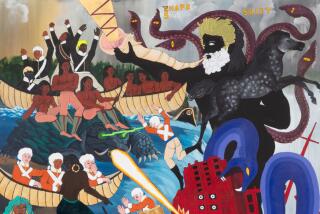Topics / SCULPTURE : Fancy Ride Into the Afterlife
- Share via
If you have to meet your maker, why not arrive in style? Why not arrive in something that expresses who you really are--er, were--rather than a run-of-the-mill rectangular box?
That’s the idea behind an array of African “fantasy coffins” on display at the Ernie Wolfe Gallery in West Los Angeles.
There’s a fish coffin, a 10-foot lobster coffin, even a Lexus coffin--all hand-carved, upholstered and ready to go.
“They were meant to be buried,” gallery owner Ernie Wolfe said recently, exhibiting a cheerfulness bordering on the macabre as he strolled among the colorful caskets. “They’re meant to be seen by the public for a few days. Then, as soon as they hit the ground, they’re goners.”
In this case, the public can view the craftsmanship at a more leisurely pace. The show opened late last month and is scheduled to end May 1, during which time 18 “Afterlife Vehicles”--including a giant, wood rainbow trout, an ear of corn, a shark and a stegosaurus--will be featured on a rotating basis.
All are representative of a genre pioneered in the mid-1960s by Kane Kwei, a Ghanaian carpenter and sculptor from near the capital city of Accra who carved coffins to reflect the achievements and fantasies of the deceased. His first effort was for an uncle whose dying wish was that he be buried in something beyond the ordinary: Kwei crafted a fishing boat.
Though they are fanciful, the coffins are not taken lightly by the families who buy them. The sculptures reflect a view of death different from that in the West, where one’s earthly exit tends to be seen with somber finality.
“It’s not death,” said Wolfe, explaining the Ghanaian philosophy that gave rise to the celebratory coffins. “It’s just another place, an extension.”
*
Encouraged by a favorable community response to the fishing boat, Kwei began building designer coffins in earnest. He stuck largely to traditional themes such as a yellow-fin tuna for fishermen and a sculpture of hen and chicks for the mother of a large family. For those with automotive aspirations, he assembled car coffins, including an “Edsel.”
Kwei himself died a year-and-a-half ago at the age of 70. (He was interred in a modestly engraved box-style coffin). But a handful of former apprentices in Ghana, chiefly Paa Willy and Theophilis Nii Anum keep his concept alive, adding contemporary flourishes that sometimes make death seem like a Disney adventure.
Some examples of their work include a Batmobile coffin, a Mickey Mouse coffin and a massive rendition of Alf, the puppet who starred in his own television series.
Wolfe, a frequent visitor to Africa and a collector of African art, seems thrilled by the new styles, which he sees as evidence of an ever-shrinking world. He predicts the coffin makers will push the limits of their craft even further as global themes and symbols penetrate Ghanaian society.
“I think there will be coffins done like they’ve never been done before.” he said.
If nothing else, the afterlife vehicles prove there is no free ride--even in the hereafter. Priced at the gallery from $4,500 to $15,000, the coffins have become status symbols for the rich in Ghana, a poor country located on Africa’s West Coast. In some cases, according to Wolfe, rival families engage in one-upmanship over who can afford the fanciest models.
Wolfe met Kwei during the late 1980s. But it was not until December that Wolfe managed to have the 18 coffins shipped to the United States, a process that involved preempting a potentially destructive search by U.S. Customs officials, who might have thought the unusual vessels were cleverly packaged contraband.
He believes the wacky caskets could be a smash hit in open-minded Los Angeles, but prospective buyers be warned: Wolfe is sizing up the rainbow trout and the lobster for himself--just in case.
“I would be heartbroken if anyone bought either of those,” he said.
More to Read
The biggest entertainment stories
Get our big stories about Hollywood, film, television, music, arts, culture and more right in your inbox as soon as they publish.
You may occasionally receive promotional content from the Los Angeles Times.










